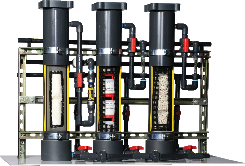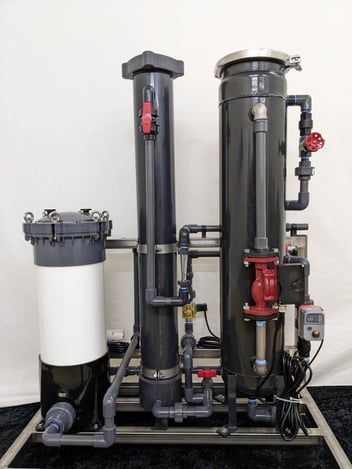Solid Cooling Technology for Data Centers
You're likely reading this article on your computer, laptop or phone that's connected to the internet. Like you, ~85% of American households have a computer, 70% are connected to the internet and 72% of Americans use social media. The increase in people connected to the internet coupled with advancements in technology that are able to connect nearly any machine imaginable to the internet (IoT), has drastically increased the amount of storage needed for all the data that's being collected.

With the increase in data being collected throughout the world, the number of data centers has grown rapidly in recent years and is expected to continue growing. There are about 3 million data centers in the United States alone! Due to the continuous upgrading and modernization requirement, the server densities are increasing to harness the computing power of the next generation of processors & chip sets are operating at higher temperatures, leading to an increasing need for cooling solutions.
The cooling solution for a data center should be:
1. Highly efficient and robust
Electricity costs are a dominant operating expense and account for over 10% of the total cost of ownership (TCO) of a data center, and on average, about 40% of a data center’s power consumption goes toward cooling the servers. Evaporative Cooling Towers are commonly used for their higher energy-efficiency when compared to other cooling technologies in many industries. A majority of data centers chose this Evaporative Cooling technology to save energy, as well as costs. With more data centers now strategically located to have easy access to energy and natural water sources, one of the challenges is to use natural water (e.g. river or lake water) for cooling towers. The seasonal changing water chemistry requires robust and reliable chemical treatments to handle the mineral scaling and deposit for ensuring heat transfer efficiency.
The seasonal changing water chemistry requires robust and reliable chemical treatments to handle the mineral scaling and deposit for ensuring heat transfer efficiency.
Dober’s patented Smart Release®Technology (SRT) was designed to handle the variability of such a situation and can achieve high energy efficiency in these mission-critical cooling towers.
2. Modulated design is versatile to meet the growing demand
As the data collected grows by the day, data centers need to make sure they have space for expansion.

All data centers are designed with considerations for future expansion to meet the fast growing demands, the same as their cooling systems. Therefore, a modulated solid treatment program, like SRT, is a perfect solution for data center cooling towers. Compared to other liquid programs, setting up Smart Release® equipment is easy and the footprint is minimalistic. Smart Feeders can be mounted to the floor, wall, or the cooling system and its PVC construction is compact and elegant. Smart feeders are versatile for handling different programs and any new feeders can easily be added.
3. Low maintenance, low risk of breakdown
A cooling failure in a Data Center could lead to overheating, and when the equipment gets too hot, it shuts down to protect itself. This could be a disaster and a loss of multi-millions of dollars to Date Centers. In 2016, the average cost of unplanned data center failure was $8,850 per minute.
As opposed to the liquid chemical treatment systems making use of pumps for continuous delivery, where most of the failures occur due to the breakdown of the pumps, the Smart Release® Technology - controlled delivery system of the time - release tablets eliminates the need for mechanical pumping as it releases the active chemistry at a constant rate, removing the probability of mechanical pump defects and malfunctions. The 30 days release profile of the tablets minimizes the frequency of changing the treatment chemicals, making the system low-maintenance
4. Cost-effective
There are peripheral costs associated with any Cooling Tower System Maintenance that includes shipping and storage costs of the Chemical treatment chemicals. By using the non-DOT regulated Smart Release® Technology, companies could save on these costs due to its Solid-state resulting in low-volume packaging in addition to reducing the carbon footprint
5. Safe Handling
SRT is a safer, non hazardous and spill-free chemical treatment option for cooling tower systems.
 Set up is convenient due to the ease of re-filling of the chemicals in contrast to the possible safety issues associated with liquid chemical treatment systems like leaks and transportation of the heavy containers to the cooling towers that are situated at a height.
Set up is convenient due to the ease of re-filling of the chemicals in contrast to the possible safety issues associated with liquid chemical treatment systems like leaks and transportation of the heavy containers to the cooling towers that are situated at a height.
Smart Release® Biocides are also available as controlled released technologies for both, oxidizing and non-oxidizing biocides that ensure safety against the growth of micro-organisms including a particular group of pathogenic bacteria, Legionella, that could cause a pneumonia-type illness called Legionnaires' disease
"...any small step taken towards making Data Center Cooling Systems more efficient will be a giant leap for energy saving and information technology."
In a typical data center, every kW saved with IT equipment can potentially result in nearly 2 kW saved in powering the data center. Also, as per the Office of Energy Efficiency and Renewable Energy, Data centers provide an opportunity for improving U.S. energy efficiency. If all U.S. data centers were 20% more efficient, it could save more than 20 billion kWh by 2020 as a nation. That translates to roughly $2 billion in cost savings. Considering this, any small step taken towards making Data Center Cooling Systems more efficient will be a giant leap for energy saving and information technology.




